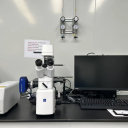 仪器分类
仪器分类

主要规格及技术指标
物镜 (objective lens): 5X, 10X, 20X, 40X
明场 (Bright Field): LED light
微分干涉 (Plastic DIC)
相差 (Phase difference)
荧光 (Fluorescence)
DAPI EX G 365, BS FT 395, EM BP 445/50
FITC EX BP 475/40, BS FT 500, EM BP 530/50
CY3 EX BP 550/25, BS FT 570, EM BP 605/70
CY5.5 EX BP 665/45, BS FT 695, EM BP 725/50
主要功能及特色
1. 明场 (BF):适合常规镜检、病理、染色样品的观察方法。特点是操作简单,视野亮度高且均匀,应用范围广。
1. Bright field (BF) : suitable for routine microscopy, pathology, and observation of stained samples. It is characterized by simple operation, high and uniform visual field and wide application.
2. 相差 (PH):利用被检物体的光程(折射率×厚度)差进行镜检,即利用干涉现象,将相位差转换为人眼可分辨的振幅差。是鉴定活细胞最实用经济的方法,但对样品厚度有要求,样品厚时易产生光晕。
2. Phase difference (PH) : the interference phenomenon is used to convert the phase difference into an amplitude difference that can be distinguished by eyes. It's the most practical and economical way to identify living cells. However, there are requirements for the thickness of the sample, and it is easy to produce halo when the sample is thick.
3. 微分干涉( PlasDIC):可观察塑料器皿中的样品,通过特制的棱镜将偏振光分解成相互垂直、强度相等的光束,光束在极近的两点(小于显微镜的分辨率)上通过被检物体,从而在相位上略有差别,使图像呈现出立体三维感觉。
3. Differential interference (PlasDIC) : samples in plastic containers can be observed, and polarized light is decomposed into beams of equal intensity and vertical to each other through a special prism, and the beams are at two points very close (less than the resolution rate of a microscope) through the inspected object, so that the phase is slightly different, so that the image presents a 3D
image.
4. 荧光( FL):物质中的电子吸收光的能量由低能状态转变为高能状态,再回到低能状态时释放出的光,即:物质吸收短波光,发射出的长波光。荧光显微镜利用荧光光源激发样品中的荧光物质,检测激发光的情况。
4. Fluorescence (FL) : the light energy absorbed by the electrons in the substance changes from a low-energy state to a high-energy state, and then returns to a low-energy state when the light is released, that is, the substance absorbs short-wave light and emits long-wave light. Fluorescence microscope can excite the fluorescent substance in the sample to detect the excitation light through fluorescent light source.
主要附件及配置
Objective lens: 5X, 10X, 20X, 40X
Channels: DAPI, FITC, Cy3, Cy5.5, BF, DIC
| 公告名称 | 公告内容 | 发布日期 |
|---|
